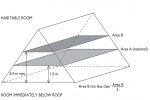Hi,
We are considering buying a dormer bungalow. We have noticed that the ceiling height requirements (i.e. that the area at 2.4m height should be at least 50% of that at 1.5m height) are not met for the upstairs bathroom.
But I am not clear if this rule is a requirement for bathrooms. I read the building regs but I am confused as it seems to depend on whether the room is a 'habitable' room?
Can anyone confirm if these ceiling height requirements are applicable to bathrooms?
Many thanks..
We are considering buying a dormer bungalow. We have noticed that the ceiling height requirements (i.e. that the area at 2.4m height should be at least 50% of that at 1.5m height) are not met for the upstairs bathroom.
But I am not clear if this rule is a requirement for bathrooms. I read the building regs but I am confused as it seems to depend on whether the room is a 'habitable' room?
Can anyone confirm if these ceiling height requirements are applicable to bathrooms?
Many thanks..
